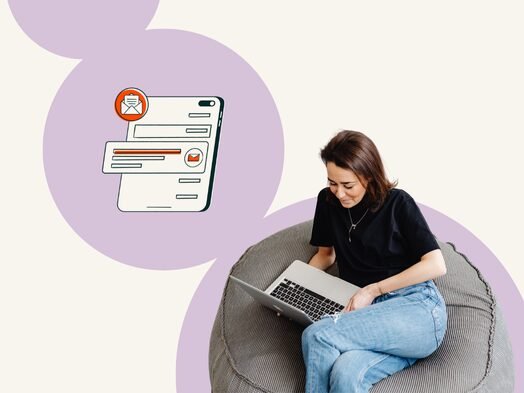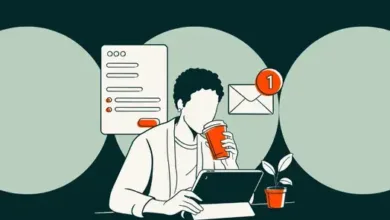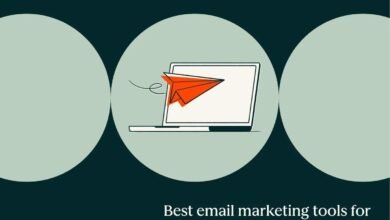Top 11 Email Marketing Tools for Restaurants in 2025

▼ Summary
– Email marketing helps restaurants manage fluctuating traffic, promote specials, coordinate reservations, and build loyalty programs.
– Email marketing tools automate tasks like reservation confirmations, customer segmentation, and targeted promotions to improve efficiency.
– Restaurants using email marketing can achieve an average 3-5x ROI and up to 25% more repeat visits with targeted campaigns.
– The article compares 11 email marketing platforms, detailing features, pricing, and suitability for different restaurant types.
– Key benefits include filling tables during slow periods, increasing order values, reducing no-shows, and building a loyal customer base.
Running a successful restaurant demands more than just great food and service; it requires smart marketing strategies that keep customers engaged and tables filled. Email marketing for restaurants provides a powerful solution for managing fluctuating customer traffic, promoting time-sensitive specials, coordinating reservations across multiple platforms, and building loyalty programs that encourage repeat visits. The right email platform automates reservation confirmations, segments customers by dining preferences and visit frequency, and sends promotions when customers are most likely to book, helping you fill tables during slow periods, increase average order values, and transform occasional diners into regular patrons.
Restaurants implementing targeted email campaigns frequently achieve an average return on investment of three to five times their initial spend, with some seeing repeat visit rates climb by as much as twenty-five percent. Platforms like HubSpot serve restaurant groups of all sizes, from individual locations to multi-unit chains, by providing integrated customer relationship management and marketing automation tools that boost reservations while strengthening customer loyalty.
Understanding Restaurant Email Marketing
Email marketing allows restaurants to maintain direct communication with their customer base through carefully targeted campaigns. Establishments use it to highlight daily specials, introduce new menu items, send reservation reminders, share exclusive offers, celebrate customer birthdays, and drive traffic during traditionally slow periods with strategic promotions. This approach creates personalized connections that generic social media posts cannot match.
| Platform | Best For | Key Features | Starting Price | Rating |
|---|---|---|---|---|
| HubSpot | Multi-location restaurant groups | Free CRM, reservation tracking, loyalty automation, revenue attribution | Free; paid plans from $9/mo | ⭐ 4.4/5 |
| Mailchimp | Independent restaurants and cafés | Pre-designed templates, automation, segmentation, customer journey mapping | Free; Essentials from $13/mo | ⭐ 4.3/5 |
| Constant Contact | Restaurants seeking simplicity | Drag-and-drop builder, event marketing, live support | From $12/mo | ⭐ 4.0/5 |
| ActiveCampaign | Restaurants needing advanced automation | Guest scoring, SMS integration, conditional workflows | From $15/mo | ⭐ 4.6/5 |
| Klaviyo | Restaurants with online ordering | Advanced segmentation, predictive analytics, revenue tracking | Free; Email from $45/mo | ⭐ 4.6/5 |
| Brevo | Growing groups using SMS | Combined email + SMS, transactional messages, unlimited contacts | Free; Starter from $8.08/mo | ⭐ 4.5/5 |
| Omnisend | Restaurants with e-commerce | Omnichannel automation, product recommendations, resend campaigns | Free; Standard from $11.20/mo | ⭐ 4.5/5 |
| Square Marketing | Restaurants using Square POS | Native POS integration, automated campaigns, customer insights | Free; Square Plus from $49/mo | ⭐ 4.3/5 |
| Toast Marketing | Restaurants using Toast POS | POS data sync, guest segmentation, automated workflows | Custom pricing | ⭐ 4.5/5 |
| Moosend | Budget-conscious restaurants | Unlimited emails, automation, landing-page builder | Free; Pro from $9/mo | ⭐ 4.6/5 |
| GetResponse | Restaurants hosting events | Event management, automation, conversion funnels | From $15.58/mo | ⭐ 4.2/5 |
Detailed Platform Analysis
HubSpot stands out for multi-location restaurant groups requiring integrated CRM, marketing automation, and reservation tracking within a single platform. Its free CRM manages guest profiles by tracking every customer interaction from initial reservations to repeat visits, including dietary preferences, favorite menu items, and spending patterns. Automated loyalty campaign workflows create email sequences that reward repeat business, celebrate customer milestones, and re-engage guests who haven’t visited recently. Revenue attribution by location and campaign shows exactly which email initiatives drive reservations, online orders, and in-person visits, connecting marketing efforts directly to financial outcomes across different locations, day parts, and promotion types.
Mailchimp serves independent restaurants and cafes seeking user-friendly automation with food and beverage specific templates. Its restaurant-oriented templates enable quick launch of promotions for daily specials, happy hour announcements, and seasonal menu reveals without design expertise. Guest journey mapping visualizes the complete dining experience from first visit to established regular, identifying communication gaps and opportunities to increase visit frequency. Behavioral automation sends targeted emails based on customer actions like reservation bookings, online orders, and email clicks, ensuring appropriate follow-up timing without manual intervention.
Constant Contact appeals to restaurants wanting straightforward email marketing with robust customer support and event promotion capabilities. Its drag-and-drop email builder creates professional restaurant communications without coding knowledge, enabling quick campaign launches even during busy service hours. Event marketing integration manages wine tastings, chef dinners, live music nights, and private events with registration, confirmations, and reminders consolidated in one location. The real-time reporting dashboard monitors campaign performance with clear visualizations of opens, clicks, and reservations, eliminating complex analytics.
ActiveCampaign suits restaurants requiring sophisticated automation and guest scoring for VIP programs and personalized marketing. Its advanced guest scoring automatically identifies highest-value customers based on visit frequency, average check size, and email engagement to create exclusive offers and premium experiences. Conditional workflow automation builds email sequences that adapt according to guest responses, dining preferences, and visit patterns, creating different communication paths for first-time visitors versus regular patrons. Integrated SMS coordinates email and text campaigns for time-sensitive communications about same-day table availability, last-minute reservations, and weather-related closures.
Klaviyo benefits restaurants with online ordering and delivery systems needing advanced segmentation and revenue attribution. Its predictive analytics use machine learning to identify guests likely to churn, forecast future order values, and recommend menu items based on past orders. Advanced segmentation with over 350 criteria creates specific guest groups according to order history, dietary preferences, spending patterns, and visit frequency for precisely targeted promotions. Revenue attribution tracking shows exactly how much income each email campaign generates from dine-in reservations, online orders, and delivery services, clearly demonstrating marketing return on investment.
Brevo supports growing restaurant groups requiring combined email and SMS capabilities with pricing based on messages sent rather than contact numbers. Its unified email and SMS platform coordinates text reminders with email promotions from one interface, confirming reservations via SMS while promoting specials through email. Transactional email capabilities automatically send reservation confirmations, online order receipts, and gift card purchase confirmations with reliable delivery. Unlimited contacts on paid plans enable building substantial customer databases without escalating costs since pricing depends on emails sent rather than contact count, making it ideal for expanding email lists.
Omnisend assists restaurants with merchandise, meal kits, or packaged goods needing e-commerce email marketing. Its omnichannel workflow automation creates unified customer journeys combining email, SMS, and push notifications based on guest behavior for consistent messaging across channels. The product recommendation engine automatically suggests menu items, merchandise, or meal kits according to previous orders to increase average order value through personalized suggestions. The campaign booster feature automatically resends campaigns to non-openers with different subject lines, giving promotions a second chance and increasing overall reach by ten to fifteen percent.
Square Marketing serves restaurants using Square POS that want native integration with their point-of-sale system. Its native Square POS integration automatically synchronizes customer data including purchase history, visit frequency, and favorite items without manual exports or third-party connectors. Automated campaign triggers set up emails that automatically send after customer visits, on customer birthdays, or when guests haven’t visited in thirty days based on actual POS data. Customer insights from POS data segment guests according to real purchase behavior, average check size, and visit patterns pulled directly from the point-of-sale system.
Toast Marketing benefits restaurants seeking deep integration with their restaurant management system. Its Toast POS integration synchronizes guest data directly from the POS system, including order history, preferences, allergies, and visit frequency for highly personalized marketing campaigns. Automated guest communication sends triggered emails and SMS based on Toast data, including post-visit thank you messages, birthday offers, and win-back campaigns for lapsed diners. Loyalty program integration connects email campaigns to Toast loyalty program data to promote point balances, reward redemptions, and tier achievements that encourage repeat visits.
Moosend appeals to budget-conscious restaurants wanting powerful automation at affordable prices. Its unlimited email sending allows as many emails as needed without per-message charges, making it economical for frequent promotions like daily specials and happy hour announcements. AI-powered subject line optimization improves open rates by analyzing performance and suggesting improvements based on millions of campaigns to make promotions stand out. The included landing page builder creates campaign pages for event registrations, online ordering promotions, and gift card sales, consolidating tools and reducing overall costs.
GetResponse suits restaurants hosting cooking classes, wine tastings, and special events needing event management capabilities. Its integrated event hosting manages virtual cooking classes, wine tastings, and chef demonstrations for up to one thousand participants without separate event software. The conversion funnel builder creates complete marketing funnels with landing pages, email sequences, and event registration that guide diners from awareness to booking. Autofunnel templates launch campaigns faster using pre-built templates for restaurant promotions that take minutes instead of hours to set up and deploy.
Advantages of Email Marketing Software for Restaurants
Filling tables during slow periods becomes systematic rather than relying on unpredictable walk-in traffic. Email marketing software promotes strategic offers during off-peak hours and less busy days, with many restaurants significantly increasing weekday lunch traffic through targeted slow-period promotions. Timed campaigns reach customers when they’re planning their meals, making empty tables profitable.
Building a loyal regular customer base keeps your establishment top of mind and converts first-time visitors into repeat patrons. Automated loyalty campaigns reward frequent visits and celebrate milestones, with many restaurants increasing repeat visit frequency through strategic email loyalty programs. Creating VIP experiences makes guests feel valued and appreciated, strengthening their connection to your brand.
Increasing average order values happens by identifying high-value menu items and promoting them to appropriate customers at optimal times. Restaurants frequently boost average check sizes by twenty to thirty percent using AI-powered systems that provide personalized menu recommendations in emails. Suggesting appetizers, premium entrees, and desserts based on past ordering behavior gently guides customers toward higher-value selections.
Reducing no-shows and cancellations becomes achievable through automated reminder emails and SMS messages that prevent forgotten reservations. Many restaurants significantly decrease no-show rates with automated confirmation and reminder sequences, sending reminders twenty-four hours before reservations with easy modification options that respect customer schedules.
Generating revenue from your email list transforms your customer database into an active income channel. Email campaigns effectively drive reservations, online orders, gift card sales, and merchandise purchases while showing exactly which promotions generate the most revenue, allowing for continuous optimization based on actual performance data.
Essential Features for Restaurant Email Marketing Platforms
POS integration automatically synchronizes customer data from your point-of-sale system without manual intervention. Reservation system integration connects with platforms like OpenTable, Resy, or proprietary booking systems. SMS capabilities enable sending text messages for time-sensitive promotions and confirmations. Segmentation by dining preferences targets customers according to dietary needs, favorite dishes, and visit patterns. Automated birthday campaigns trigger special offers on customer birthdays automatically. Mobile optimization ensures proper display on smartphones where most restaurant emails are opened. A/B testing compares subject lines, send times, and offers to improve performance. Behavioral automation triggers follow-ups based on reservations, orders, and website visits. Revenue attribution tracks which campaigns drive reservations and online orders. Event marketing tools promote and manage special events, tastings, and private parties.
Selecting the Right Email Marketing Tool: A Step-by-Step Approach
Begin by mapping your restaurant marketing workflows, documenting all customer touchpoints including reservation confirmations, post-visit thank-you messages, birthday offers, loyalty rewards, event promotions, daily specials, seasonal menu launches, and win-back campaigns for lapsed customers. Identify manual processes that could benefit from automation to save staff time and ensure consistency.
Identify must-have features based on your restaurant type. Quick-service establishments need online ordering integration and mobile optimization. Fine dining restaurants require reservation system integration and VIP guest management capabilities. Multi-location groups need centralized reporting and location-specific campaign management. Create separate lists for absolute requirements versus nice-to-have features to guide your selection process.
Compare ease of use and team compatibility by testing platforms during free trial periods. Determine whether your team can create campaigns independently between service shifts or will require ongoing support. Platforms like Constant Contact and Mailchimp suit beginners, while ActiveCampaign and HubSpot offer more advanced capabilities that may require additional expertise.
Check costs at scale by calculating expenses as your customer database grows over twelve to twenty-four months. Some platforms charge per contact while others bill per email sent. Project your list size including email captures from reservations, WiFi signups, and loyalty programs, then verify pricing at that volume. Include potential SMS messaging costs in your calculations.
Choose a flexible platform that scales without forcing migration later. HubSpot supports restaurants from single locations through multi-unit chains with one unified system. Starting with the free tier and upgrading as needed eliminates data migration requirements and maintains continuity as your business expands.
Creating Effective Restaurant Email Campaigns
Define clear campaign goals and target audiences before creating content. Determine whether you’re filling tables during slow periods, promoting new menu items, building your loyalty program, generating gift card sales, or re-engaging lapsed customers. Specific objectives guide everything from subject lines to offers and calls to action.
Segment your customer list into targeted groups including first-time visitors versus regulars, lunch versus dinner customers, dietary preferences like vegetarian or gluten-free, high spenders versus value seekers, and inactive guests. Segmented restaurant campaigns typically generate sixty-five percent higher open rates than generic broadcasts to entire lists.
Design visually appealing, mobile-optimized templates that showcase your food beautifully while displaying properly on smartphones, where most restaurant emails are opened. Use high-quality food photography, single-column layouts, clear visual hierarchy, and large tap-friendly buttons for reservations and ordering.
Write subject lines that immediately communicate value and urgency. Effective examples include “Tonight Only: 20% Off All Wine,” “Your Birthday Dinner is On Us,” “New Fall Menu Just Dropped,” or “Table for 2 Available This Saturday.” Keep subject lines under forty characters and incorporate time-sensitive language to encourage immediate action.
Include one clear call-to-action directing recipients toward a single primary action like making a reservation, ordering online, purchasing a gift card, registering for an event, or redeeming an offer. Multiple CTAs create confusion and reduce conversion rates. Position your primary call-to-action prominently with contrasting colors and action-oriented text.
Set up automated follow-up sequences triggered by guest behavior. Send thank you emails within twenty-four hours of dining experiences. Follow up with review requests two to three days later. Create win-back campaigns for guests who haven’t visited in thirty, sixty, or ninety days with progressively stronger offers to encourage return visits.
Monitor performance and adjust timing by tracking opens, clicks, reservations, and revenue generated. Test different send times to discover when your customers are most likely to engage. Many restaurants achieve best results sending lunch promotions Tuesday through Thursday mornings and dinner promotions Thursday and Friday afternoons.
Common Questions Answered
What represents the best email marketing tool for restaurants? HubSpot consistently ranks as the top choice because it combines email, SMS, CRM, and reservation tracking within a single platform. The free tier includes unlimited contacts, email marketing, forms, landing pages, and CRM access suitable for single-location restaurants and small chains. Multi-location groups benefit from revenue attribution connecting campaigns to reservations and online orders by specific location. Restaurant groups using HubSpot frequently increase repeat customer visits through automated loyalty campaigns and personalized offers.
Which features matter most in restaurant email marketing tools? Prioritize POS integration, reservation system connectivity, SMS capabilities, segmentation by dining preferences, automated birthday campaigns, mobile optimization, behavioral automation, A/B testing, revenue attribution, and event marketing tools. POS integration automatically synchronizes customer data without manual exports. SMS capabilities prove valuable for time-sensitive promotions and reservation confirmations. Mobile optimization remains essential since most emails are opened on mobile devices.
Is HubSpot effective for restaurants? Absolutely. HubSpot provides a unified platform for marketing, reservations, and guest management specifically designed for hospitality businesses. The free CRM tracks every customer interaction including visit history, favorite dishes, dietary restrictions, and spending patterns. Marketing automation enables creating workflows for reservation confirmations, post-visit thank-you messages, and loyalty rewards without technical expertise. Multi-location restaurant groups often increase online ordering revenue using HubSpot’s automated campaigns and segmentation, while single locations can start with free features and scale up as they grow.
What does restaurant email marketing software typically cost? Pricing ranges from zero to over thirty-six hundred dollars monthly depending on customer database size, feature requirements, and restaurant scale. Free tiers generally support two hundred fifty to one thousand contacts with basic features. Entry-level paid plans cost twelve to twenty-nine dollars monthly for under one thousand contacts. Mid-market restaurants with twenty-five hundred to five thousand contacts typically spend fifty to two hundred dollars monthly. Large restaurant groups with ten thousand-plus contacts invest five hundred to thirty-six hundred dollars or more monthly. Some platforms charge per contact while others bill per email or SMS sent, making careful comparison essential as your list expands.
How can restaurants build their email lists effectively? Grow email lists through WiFi signup forms requiring email addresses for access, table-side tablet signups offering birthday rewards, reservation system integrations automatically capturing emails, point-of-sale prompts during checkout, website popups providing first-visit discounts, social media contests requiring email entries, and in-store signage promoting loyalty programs. Restaurants typically grow email lists three to five times faster using multiple capture points throughout the customer journey. Always provide clear value in exchange for email addresses to encourage participation.
HubSpot: The Premier Choice for Restaurant Email Marketing
HubSpot combines email marketing, SMS, CRM, and reservation tracking into one comprehensive platform specifically designed for hospitality businesses. Over 184,000 companies worldwide trust HubSpot because it eliminates the need for multiple disconnected tools, streamlining operations and improving marketing effectiveness.
Key HubSpot features for restaurants include a unified guest database and marketing platform that manages every customer interaction from first reservation to fiftieth visit, including dietary preferences, favorite dishes, allergies, and spending patterns in one accessible system. Automated reservation and loyalty workflows create email and SMS sequences triggered by reservations, visit milestones, and guest behavior using intuitive drag-and-drop automation with conditional logic that requires no technical expertise. Multi-location revenue attribution tracks which campaigns drive reservations, online orders, and in-store visits by location, day part, and promotion type to clearly identify what’s working.
The impact of HubSpot on restaurants demonstrates its effectiveness. Multi-location restaurant groups increase repeat customer visits using automated loyalty campaigns that reward visit frequency and spending milestones. Restaurants using HubSpot generate more online ordering revenue by segmenting customers according to order history and sending personalized menu recommendations. Independent establishments reduce no-show rates through automated confirmation and reminder sequences via email and SMS. Restaurant chains save approximately fifteen hours weekly per location by automating birthday offers, post-visit thank you messages, and win-back campaigns.
HubSpot’s free tier offers complete CRM and email marketing capabilities without requiring credit card information. Paid tiers begin at nine dollars monthly and scale to enterprise solutions featuring advanced analytics, multi-location reporting, and API integrations with major POS and reservation systems.
(Source: HubSpot Marketing Blog)





